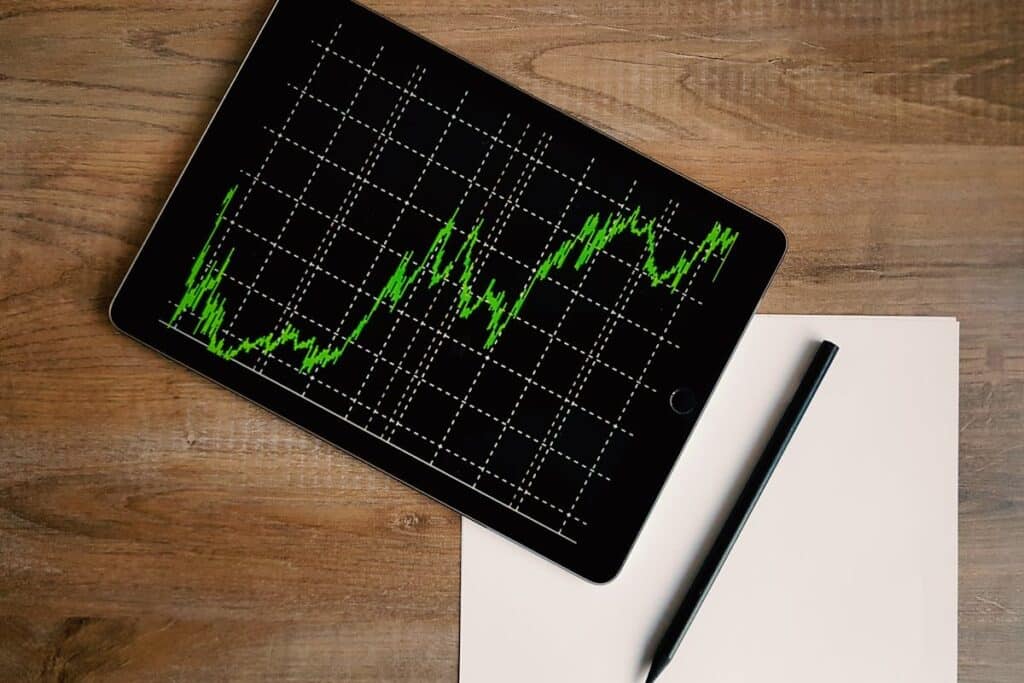The Dow Jones Industrial Average (DJIA), commonly referred to simply as “the Dow,” is one of the most recognized stock market indices in the world. Created by Charles Dow in 1896, it serves as a barometer of the overall health of the U.S. stock market and economy. Investors, analysts, and everyday people alike look to the DJIA to gauge the market’s performance and predict economic trends. But what does the stock price of the Dow Jones actually represent, and how can you understand it better? This guide will break down the components, calculation, and significance of the DJIA’s stock price. Also, after reading our article, you will know what is the stock price of Dow Jones.
What Is the Dow Jones Industrial Average?
The Dow Jones Industrial Average (DJIA), often simply called “the Dow,” is one of the oldest and most widely recognized stock market indices in the world. It was created by Charles Dow, the co-founder of Dow Jones & Company, and first published in 1896. The DJIA tracks the performance of 30 large, publicly-owned companies based in the United States that are leaders in their respective industries.
These companies are selected to represent a broad cross-section of the U.S. economy, covering sectors such as technology, finance, healthcare, and consumer goods. Some of the well-known companies currently included in the DJIA are Apple, Microsoft, Boeing, and Coca-Cola.
The Dow is a price-weighted index, meaning that the companies with higher stock prices have a greater impact on the index’s movement than those with lower stock prices. This is different from other indices, like the S&P 500, which are market-cap-weighted. The DJIA serves as a barometer of the overall health of the stock market and is often used by investors and analysts to gauge market trends and economic conditions.

How Is the Dow Jones Stock Price Calculated?
The DJIA is calculated by adding up the stock prices of the 30 companies it tracks and then dividing that total by a divisor. The divisor is adjusted for stock splits, dividends, and other events that might otherwise distort the index. This method ensures that the index reflects the performance of the stock market accurately over time.
For example, if the total of the stock prices of all 30 companies in the DJIA is $4,500 and the divisor is 0.145, the DJIA would be calculated as follows:
DJIA= Total Price of Stocks/Divisor = 4.500/0.145 ≈ 31,034
Components of the Dow Jones
The Dow Jones Industrial Average (DJIA) consists of 30 large, publicly-traded companies that are leaders in various sectors of the U.S. economy. These companies are selected to represent the overall health of the economy, and their performance is seen as a reflection of broader market trends. The components of the DJIA are periodically reviewed and adjusted to ensure the index remains representative of the current economic landscape.
Here are the major sectors represented and examples of companies within each:
1. Technology
- Apple Inc. (AAPL): A global leader in consumer electronics, software, and digital services.
- Microsoft Corporation (MSFT): One of the largest technology companies, known for its software products and cloud services.
- Cisco Systems (CSCO): A leading company in networking hardware, telecommunications equipment, and high-tech services.
2. Healthcare
- Johnson & Johnson (JNJ): A multinational corporation that develops medical devices, pharmaceuticals, and consumer health products.
- Merck & Co. (MRK): A global healthcare company known for its prescription medicines, vaccines, and biologic therapies.
- UnitedHealth Group (UNH): A diversified health and well-being company offering healthcare coverage and benefits services.
3. Finance
- Goldman Sachs (GS): A leading global investment banking, securities, and investment management firm.
- JPMorgan Chase & Co. (JPM): The largest bank in the U.S., providing financial services worldwide.
- American Express (AXP): A multinational financial services corporation known for its credit card, charge card, and travel-related services.
4. Consumer Goods
- Coca-Cola Company (KO): A global beverage leader, best known for its flagship soft drink, Coca-Cola.
- Procter & Gamble (PG): A multinational consumer goods corporation with a wide range of products, including personal health/consumer health, and hygiene products.
- Nike Inc. (NKE): A leading designer and manufacturer of sports footwear, apparel, and equipment.
5. Industrials
- Boeing (BA): One of the largest aerospace and defense manufacturers in the world.
- 3M Company (MMM): A diversified technology company with products in various sectors including healthcare, consumer goods, and industry.
- Caterpillar Inc. (CAT): A leading manufacturer of construction and mining equipment, diesel and natural gas engines, and industrial turbines.
6. Energy
- Chevron Corporation (CVX): One of the world’s largest oil and gas companies, involved in every aspect of the energy sector.
7. Consumer Services
- McDonald’s Corporation (MCD): The world’s largest fast-food restaurant chain by revenue.
- The Walt Disney Company (DIS): A diversified multinational mass media and entertainment conglomerate.
8. Materials
- Dow Inc. (DOW): A global leader in materials science, providing solutions in packaging, infrastructure, and consumer care.
9. Telecommunications
- Verizon Communications (VZ): A leading provider of wireless services, broadband, and telecommunications.
These companies are selected based on their significance in their respective industries, their history of stable earnings growth, and their ability to influence market trends. The composition of the DJIA is not static; companies can be added or removed based on changes in the economy or shifts within specific industries. The goal is to maintain a well-rounded reflection of the U.S. economy within the index.
Significance of the Dow Jones Stock Price
The Dow Jones Industrial Average (DJIA) stock price holds significant importance in the financial world for several reasons. As one of the oldest and most widely recognized stock market indices, the DJIA serves as a key barometer of the overall health of the U.S. economy and the stock market. Here’s why the DJIA’s stock price is so significant:
1. Indicator of Market Sentiment
The DJIA reflects investor sentiment about the economy. A rising DJIA typically indicates optimism among investors, suggesting that they have confidence in economic growth and corporate profitability. Conversely, a declining DJIA can signal pessimism, with concerns about economic slowdown or other negative factors.
2. Economic Barometer
The DJIA is often seen as a proxy for the broader U.S. economy. While it only includes 30 companies, these are large, well-established firms that play significant roles in their respective industries. As such, changes in the DJIA can provide insights into the overall economic climate, including trends in employment, consumer spending, and corporate investment.
3. Benchmark for Investment Performance
Investors and fund managers frequently use the DJIA as a benchmark to measure the performance of their investment portfolios. If a portfolio outperforms the DJIA, it indicates that the investor is achieving better returns than the market average. On the other hand, underperformance relative to the DJIA suggests that the investor’s returns are lagging behind the broader market.
4. Influence on Investor Behavior
Significant movements in the DJIA can influence investor behavior. For example, a sharp decline in the DJIA might trigger panic selling as investors rush to protect their assets, while a substantial rise might encourage more buying as investors try to capitalize on the upward trend. These reactions can further amplify market movements.
5. Impact on Economic Policy
Policymakers, including the Federal Reserve, closely monitor the DJIA and other market indices when making decisions about monetary policy. A major downturn in the DJIA might prompt the Federal Reserve to consider lowering interest rates or implementing other measures to stimulate economic activity. Similarly, a strong DJIA could lead to policy tightening to prevent the economy from overheating.
6. Media and Public Perception
The DJIA is frequently reported in financial news and is one of the most cited indices in the media. Its performance is often used to convey the state of the economy to the general public. Because of its prominence, significant changes in the DJIA can shape public perception and confidence in the economy.
7. Corporate Decision-Making
Companies listed on the DJIA are often large, influential firms whose stock prices can be sensitive to broader economic trends. A declining DJIA might lead companies to be more cautious with their spending, delay expansion plans, or reduce hiring. Conversely, a rising DJIA might encourage companies to invest in growth initiatives, make acquisitions, or increase dividends to shareholders.

How to Track the Dow Jones Stock Price
There are several ways to track the DJIA stock price:
- Financial News Websites: Major news outlets like CNBC, Bloomberg, and Reuters provide real-time updates on the DJIA.
- Stock Market Apps: Many mobile apps allow you to track the DJIA and other indices on the go. Popular apps include Yahoo Finance, Robinhood, and E*TRADE.
- Stock Market Index Funds: You can invest in index funds that track the DJIA. This way, your investment directly reflects the index’s performance.
- Market Reports: The DJIA is also reported on during daily market updates on television, radio, and online news platforms.
Why Does the Dow Jones Stock Price Matter?
The Dow Jones Industrial Average (DJIA) stock price matters because it serves as a vital indicator of the U.S. economy’s overall health and investor sentiment. Comprising 30 of the largest and most influential companies in various industries, the DJIA reflects the performance of key sectors within the economy. A rising Dow suggests optimism, signaling that businesses are performing well and that the economic outlook is positive. Conversely, a declining Dow can indicate economic concerns, prompting caution among investors and policymakers.
The DJIA also acts as a benchmark for investors, allowing them to gauge the performance of their portfolios against the broader market. Many financial decisions, from corporate investments to government policy adjustments, are influenced by movements in the Dow. Additionally, due to its prominence in financial news, the DJIA plays a significant role in shaping public perception of the economy.
In summary, the Dow Jones stock price matters because it is a widely recognized measure of economic and market conditions, influencing everything from investment strategies to policy decisions, while also reflecting the confidence or concerns of the market as a whole.
Conclusion
The Dow Jones Industrial Average is more than just a number—it’s a key indicator of the health and direction of the U.S. economy. Understanding the DJIA’s stock price, how it’s calculated, and its broader implications can help you make informed decisions in your investments and gain insight into market trends. Whether you’re a seasoned investor or just starting, keeping an eye on the DJIA can provide valuable context for your financial strategy.
